The Path to Theater Profit, Relieved Customers
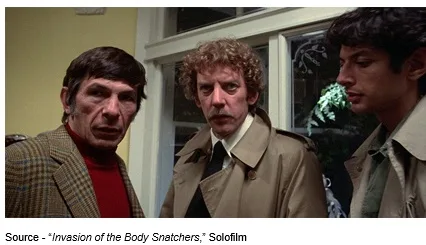
Admit it. When you go anywhere, the first thing you unconsciously check is the bathroom location.
According to movie industry analyst Stephen Follows, it’s human nature and it’s important. Back when we regularly went to movies in theaters, we always visited them before we took our seat.
Of course, we don’t even think about it when we stream movies at home.
We settle down with snacks/drinks after a busy day, we go to one of our four streaming services and see what they recommend.
You’ve probably noticed that the longer you stick them the better they get at suggesting projects that you’ll enjoy.
Yeah … they really do learn.
We grinned with delight when Warner dropped Matrix:Resurrection on HBO Max on the same date they released it in the theater.
Of course, the simultaneous release killed the gate because folks everywhere could instantly watch it free, thanks to pristine pirated copies.
Source – WarnerBros
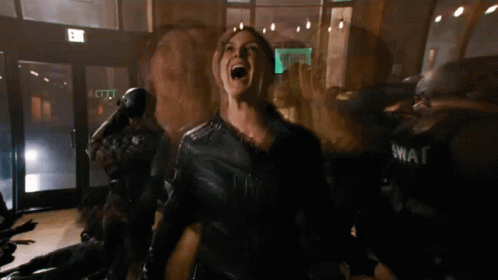
That…sucks!
We don’t “go to movies” much anymore because so much great stuff is streamed so we chose the convenience of seeing Keanna’s 23-year return to the machine-controlled Matrix at home rather than in a dark room with a bunch of strangers.
One big reason? We didn’t have to worry about having to take a “break” and miss some of the action during the 2h 28m Kung-Fu fight against programmed reality artificial agents.
We simply hit pause; got a drink, more popcorn, other things and pick the action up again.
But we are a little concerned about our next trip to the cinema to finally watch Tom Cruise take to the sky in his wildly touted Top Gun sequel.
Cruise and Paramount were smart enough to give the new film a 45-day window, so waiting that long to see it at home seems a stretch.

The last one was 1h 50m and we’re not quite sure how long this one is going to be but hey … Maverick is 35 years older so if he can make it through the entire film, maybe we can too.
Besides, the film has been pushed back three times, so we think/hope it’s going to be worth the wait/physical hardship.
With our seat in seat endurance, we wondered about the runtimes of feature films because they seem to be getting longer.
The Academy of Motion Picture Arts (AMPAC), American Film Institute (AFI), and British Film Institute (BFI) say a feature film must run longer than 40m and Screen Actors Guild (SAG) says 60M plus.
Unfortunately, they didn’t bother setting an upper limit.
According to Stephen Follows, the shortest film listed in IMDb (Internet Movie Database) is 43M, the longest is 450M.
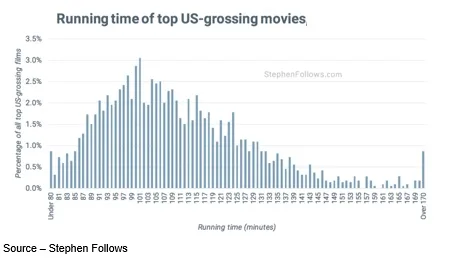
The most popular runtime is 90-100m and the vast majority are 80-120m.
In case you’re curious, the first narrative feature film was the 60-minute The Story of the Kelly Gang (1906, Australia).
And yes, over the years films have gotten longer … and more expensive.
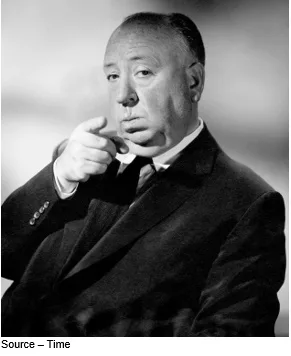 We’re not sure how long a motion picture should be, but Alfred Hitchcock once said, “The length of a movie should be directly related to the endurance of the human bladder.”
We’re not sure how long a motion picture should be, but Alfred Hitchcock once said, “The length of a movie should be directly related to the endurance of the human bladder.”
Obviously, no filmmaker takes that into consideration today.
Run times shrunk to 120-160m back in the mid-70s so they would fit on the standard VHS (video home system) cassette.
Movies settled into a manageable run time of 116m. But filmmakers were complaining they needed more run time to tell compelling stories.
Theater owners were begging for studios to deliver spectacular stuff to entice people to leave their big home screens for a totally immersive experience on their darkened outsized environments.
BAM! 2h 30m films came into vogue.
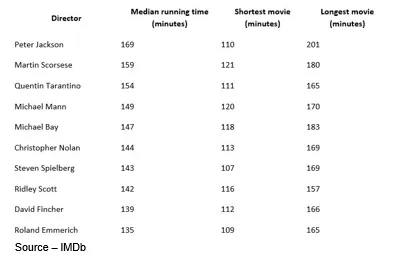
The longer run times meant one less screening time a day for theaters, which meant lower ticket sales even as the trend was already on its way down.
The story commonly told around Hollywood is that when James Cameron first told studio executives the final running time for Titanic, they freaked out.
They demanded cuts.
He vehemently responded, “You want to cut my movie? You’re going to have to fire me! You want to fire me? You’re going to have to kill me!”
Titanic hit theaters with a run time of 3h 14m and you should count yourself lucky.
He originally wrote it as a 4h epic.
He did better with Avatar – 2h 42m – and we’ll see where Avatar 2, 3,4 come in at.
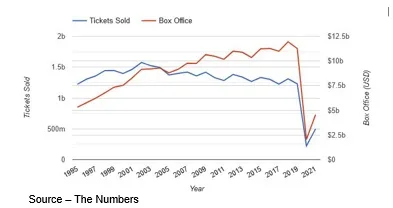
To counter the downward ticket sales trend, studios/filmmakers now concentrate on projects the younger crowd (67 percent, mostly male 18–34-year-olds) find “irresistible” – superheroes, slashers, sequels.
M&E has become a lean, mean business with fewer theaters and a growing number of streaming services, all chasing the same dollar.
Filmmakers are focused on outdoing each other, studios want to keep their A-Listers happy and theater owners are busy blowing smoke as to how much better things are now.
Aron (AMC), Greidinger (Cineworld), Zoradi (Cinemark) and the rest of the large/small theater owners are overlooking an obvious solution to their problem – people young and old need a bathroom break.
In recent years, British film analyst Stephen Follows, and several other authors have said there’s a sound reason for the intermission – which disappeared in the 1980s in the U.S. and ultimately around the globe.
Follows noted that the average human bladder can hold about 16 oz (a can of soda) and while the Guinness World Record is 39 pints, the person probably won’t enjoy the movie.
A small AMC soda is about 32 oz., about twice the normal bladder capacity; and since you’re slurping it in between fists full of salty, greasy popcorn, you’ve probably finished the soda before the first hour of the film.
You do the math.
Yep! Doesn’t take long for a 16 oz. bladder to be overpowered by a 32 oz. drink.
At home, that’s no problem because you can pause your epic but, in the theater, you have to run like heck – both ways – and try to figure out what you missed.
And we all know that was the best action in the entire film!
Back in the old days, theaters had 2, 3 or more intermissions because the projectionist needed to change film reels.
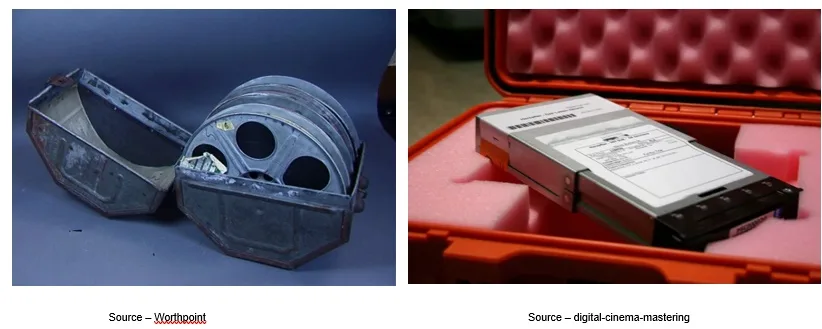
But with digital films, the projectionist inserts the DCP (digital cinema package), and the movie will play for hours.
A single DCP is probably adequate to keep you in your seat through the entire Hobbit Trilogy – The Fellowship of the Rings – 228m, Two Towers – 235m, Return of the King – 263m, Unexpected Journey – 182m, Desolation of Smaug – 186m, Battle of the Five Armies – 1564m – a total of 1,258m and still have room for coming attractions.
Think how much more enjoyable the viewing experience would be and how much more profit the theater could rack up if they inserted a bunch of intermissions.
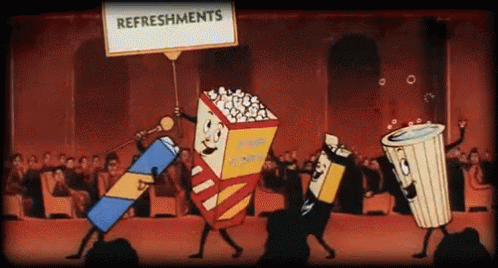
Folks could mob the concession stand to get more popcorn; more soda; more M&Ms, Milk Duds, Sugar Babies, Dots, Hot Tamales and other very profitable junk foods.
Want to make even more money?
Run ads for all those delicious, nutritious foods/drinks.
Best of all, you can rationalize the break because you’re allowing folks to give their mind a break from the heavy action of the film.
They get to check their phones and respond to all the text messages they received instead of doing it while the film is running.
They have an opportunity to analyze and exchange ideas/information with others in the cinema to clarify scenes and talk about the plot and what’s going to happen next.
Just talking to people and taking necessary breaks enrich the entire experience.
Even though Netflix lets subscribers pause, rewind and fast forward any time they want; Reed, Ted and crew also analyze all of their viewership data to determine what folks wanted in addition to killer films.
The average length of a Netflix-produced fiction film is 97m while documentaries are 89m long – long enough to satisfy awards committees and short enough to keep their 222M plus subscribers recommending their films/service to others.
We don’t see theatrical productions getting shorter in the future, our need to take breaks aren’t going to improve and ticket holders aren’t going to be able to control how long a film will play nonstop.
So maybe it’s time for cinema owners to take back control of their house and do something that will benefit ticket buyers and them.
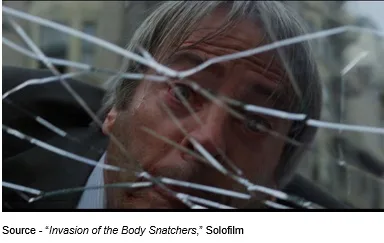 Hopefully, theater owners will think about how they can really improve their bottom lines, give movie house goers some relief and listen to Invasion of the Body Snatchers Running Man when he pleaded, “Help me! You’re next! Please!”
Hopefully, theater owners will think about how they can really improve their bottom lines, give movie house goers some relief and listen to Invasion of the Body Snatchers Running Man when he pleaded, “Help me! You’re next! Please!”
Meanwhile, we’re looking forward to our May trip to the cinema because … We’ve got a need for speed.
Of course, we’ll check out the men’s room, bypass the half-gallon drink and will whip right by Aron’s salty popcorn.
After all, now we can buy AMC’s microwaveable popcorn at the store, pop it at home https://tinyurl.com/yjj9b9j8 and enjoy it with all of our streaming content.
# # #
Andy Marken – [email protected] – is an author of more than 700 articles on management, marketing, communications, industry trends in media & entertainment, consumer electronics, software, and applications. An internationally recognized marketing/communications consultant with a broad range of technical and industry expertise especially in storage, storage management and film/video production fields; he has an extended range of relationships with business, industry trade press, online media, and industry analysts/consultants.